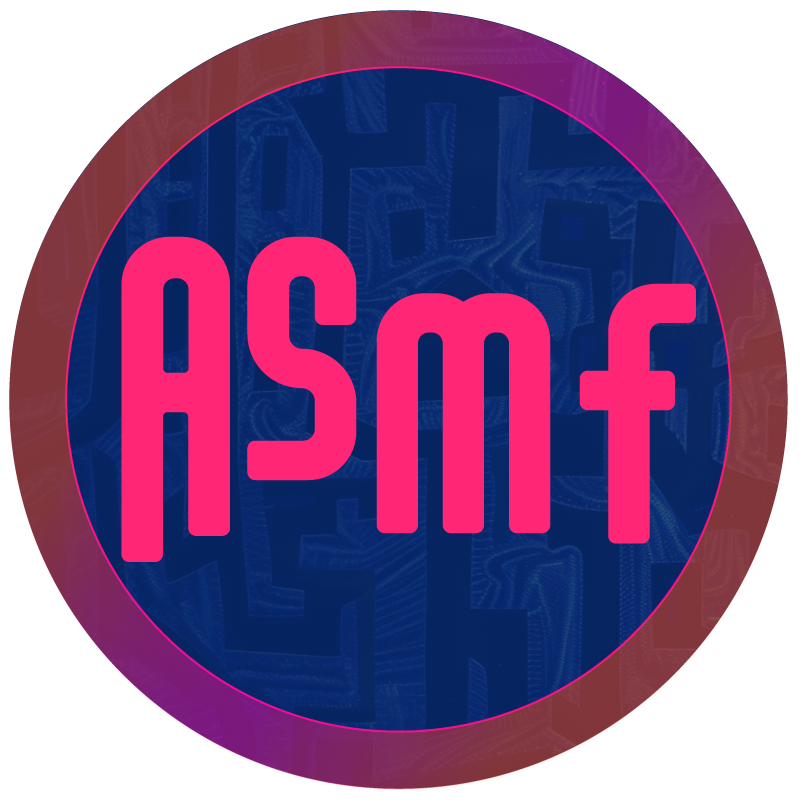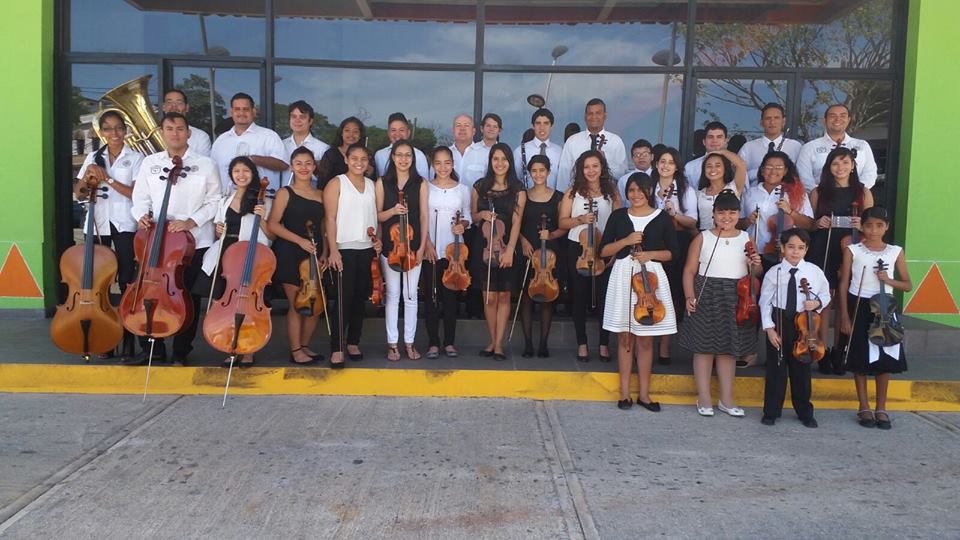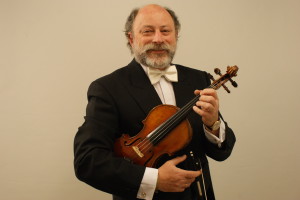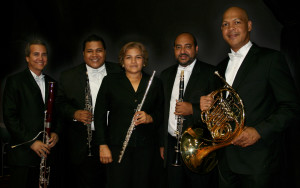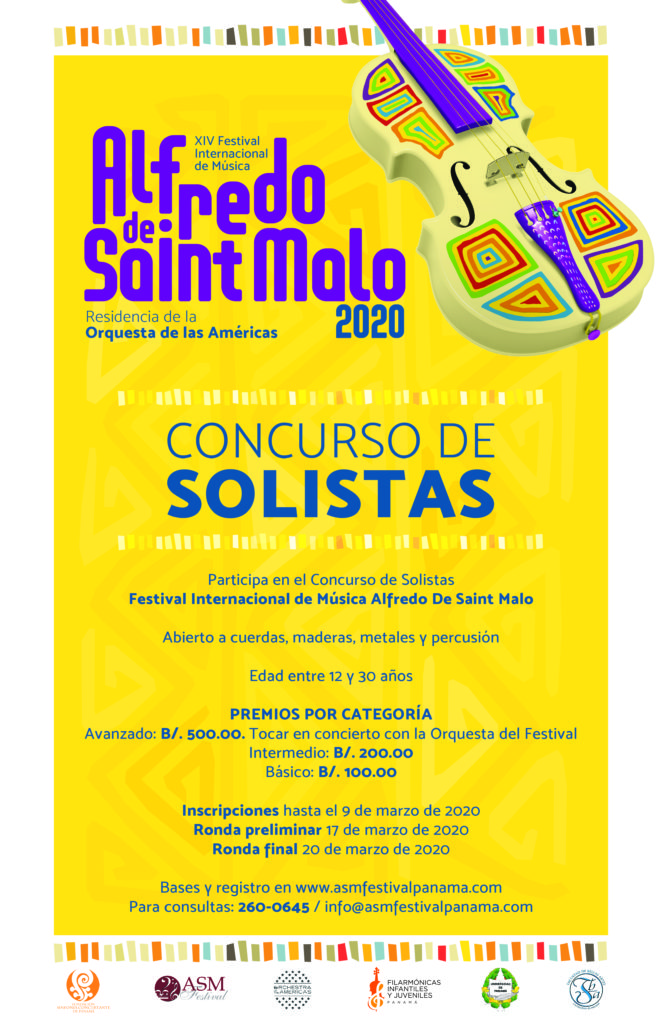(Español) Federico Díaz
Isaac Casal – Director Artístico
Organizado por la Fundación Sinfonía Concertante de Panamá, el Festival Internacional de Música Alfredo De Saint Malo (ASM) fue creado en el año 2007 por el violonchelista panameño Isaac Casal. Con la guía y el respaldo de músicos panameños, instituciones musicales como la Orquesta Juvenil de las Américas, la Universidad de Baylor y la Asociación Nacional de Conciertos. Actualmente el festival es apoyado por mas de 30 instituciones culturales, orquestas y universidades internacionales. El Festival ASM tiene como propósito reunir a músicos nacionales e internacionales en un gran intercambio cultural y artístico. Durante 10 noches de conciertos, se brindan varios géneros musicales de diversas épocas; desde obras del compositor J.S. Bach a nuevos y talentosos compositores de nuestra época. En este año 2016 se celebra la décima edición del festival, siendo considerado actualmente uno de los más variados de la región latinoamericana. Además, el Festival de Música Alfredo De Saint Malo permite a jóvenes músicos panameños y latinoamericanos, y también a los educadores del país, que tengan acceso a artistas de renombre mundial que motivarán su pasión hacia la música, demostrarán nuevas y mejores técnicas de enseñanza y darán testimonio de la disciplina que conlleva el ser un gran artista. Así mismo mostrar a los participantes, turistas y músicos extranjeros el gran talento y riqueza de nuestros artistas panameños.
UNACHI String Orchestra
RESEÑA ORQUESTA DE CUERDAS UNACHI
La Orquesta de Cuerdas de la Universidad Autónoma es el resultado del Programa de Educación Continua, Veranos Culturales de la Vice Rectoría de Extensión, de la Universidad Autónoma de Chiriquí iniciado en el año 2,014; está integrado por jóvenes pertenecientes a diferentes planteles de la provincia; cabe destacar también la participación de jóvenes hijos de Docentes y administrativos de la Institución como estudiantes regulares quienes cursan en las diferentes Facultades de la Universidad Autónoma de Chiriquí como: la Facultad de Derecho y Ciencias Políticas, Facultad de Administración de Empresas, Facultad de Humanidades en las Carreras de Inglés, Música, sicología.
Como objetivo principal tiene la integración en sana convivencia fomentando los valores cívicos y morales de nuestra juventud Chiricana.
Esta agrupación Musical Infantil – Juvenil ha participado exitosamente en eventos protocolares, culturales, Festival Nacional Alfredo de Saint Malo, conciertos pedagógicos dentro y fuera de la Universidad Autónoma de Chiriquí; interpreta repertorio BARROCO, CLÁSICO, POPULAR, TRADICIONAL.
La Orquesta de Cuerdas de la UNACHI está adscrita a la Vicerrectoría de Extensión bajo la Dirección musical del Maestro Ovidio E. Castillo asistido por el Licenciado Jorge Farquéz.
Esteban Prentki
Esteban Prentki
Perteneciente a una familia de reconocida trayectoria musical, nació en la ciudad de Montevideo, Uruguay. En su ciudad natal comienza a estudiar piano con Sarah Bourdillon de Santórsola y luego violín con el maestro Jorge Risi. Posteriormente ingresa en el Conservatorio Nacional de Música de Uruguay donde prosigue su formación con el maestro Risi, y más tarde con los maestros Nelson Casale y Nelson Govea.
Fue integrante de la Orquesta Sinfónica del S.O.D.R.E, Orquesta Sinfónica Municipal de Montevideo y Orquesta Nacional de Cámara de Uruguay.
Ha formado parte de los siguientes conjuntos de cámara: el Trío Prentki junto a Horst Prentki en clarinete y piano, y German Prentki en violonchelo; el Cuarteto Anglo que obtuvo la mención al “Mejor Conjunto de Cámara” en las temporadas 79 y 80 otorgada por votación de la crítica especializada; y el Sexteto Barroco de Montevideo. Intervino en el estreno mundial de la “Suite Punta del Este” con Ástor Piazzolla en 1977. Efectuó grabaciones, una de conciertos de oboe de Vivaldi y Albinoni junto al oboísta León Biriotti, y otra con obras del compositor uruguayo Héctor Tosar.
En Argentina obtuvo una beca otorgada por el Dr. Ricardo Gruneisen por intermedio del Mozarteum, para realizar estudios de perfeccionamiento con el maestro Ljerko Spiller desde 1978 hasta 1984.
Fue becado entre 1981 y 1984 por la Asociación Camping Musical Bariloche para asistir a los cursos de música de cámara dictados por el maestro Spiller; luego concurrió ya como docente, en reiteradas oportunidades.
Formó parte del Cuarteto de Cuerdas Buenos Aires y es creador de Buenos Aires Salonmusik.
En carácter de artista invitado actuó con la Camerata Bariloche, Academia Bach de Buenos Aires y Festivales Musicales de Buenos Aires.
Desde 1984 es integrante de la Orquesta Filarmónica de Buenos Aires como solista adjunto de los segundos violines.
En calidad de interprete de tango es invitado por Leopoldo Federico, Horacio Salgán, Walter Ríos, Daniel Binelli, Oscar López Ruiz y César Angeleri; también actuó en los espectáculos de Armenonville y “Forever Tango”. Con estos artistas y espectáculos efectuó giras y grabaciones entre las que se destaca el CD “Tango Fatal” de Carlos Franzetti, que recibió un premio Grammy.
Tempus Woodwind Quintet
EL QUINTETO CLASICO DE VIENTOS “TEMPUS” fundado en enero de 1990, es un grupo de cámara cuya labor ha estado dirigida a la interpretación y divulgación de la música de Cámara en Panamá. Actualmente está integrado por:
ELIETTE D. APOLAYO, flautista, miembro de la Orquesta Sinfónica Nacional; fundadora y Directora del Quinteto.
GUSTAVO VEGA, corno francés. Docente y miembro de la Orquesta Sinfónica Nacional.
DANIEL AGUDO, Primer Fagot de la Orquesta Sinfónica Nacional y docente del Instituto Nacional de Música.
JORGE OLIVA, Clarinete. Miembro de la Banda Republicana y actual Director del Plan Juvenil.
LEOPOLDO MAGALLÓN, oboe. Estudiante de la Facultad de Bellas Artes. Oboísta de la Orquesta Sinfónica Nacional.
VII Alfredo De Saint Malo 2014 International Music Festival
The VIII Alfredo De Saint Malo International Music Festival 2014 will be held in Panama City from May 29 to June 8, and it is dedicated to Panamanian composer Fermín Castañeda Del Cid (1930-2013).
The faculty of the ASM Festival includes musicians from the Metropolitan Opera Orchestra and faculty members from the Youth Orchestra of the Americas and the schools of music of Louisiana State University, the University of Northern Colorado, and the University of Minnesota.
The student body of the festival includes young musicians from Panama, Latin America, the Caribbean, and the United States.
In addition to the participation of renowned international soloists such as pianist Michael Gurt , flutist James Hall, bassist Yung- Chiao Wei, percussionist Fernando Meza, and violinist Lin He, the festival features laureated Venezuelan conductor Carlos Riazuelo, child virtuoso on the piano William Chen, and national artists such as Jorge Ledezma Bradley, Ingrith Saavedra, the National Symphony Orchestra of Panama, and the Camerata Panama.
This is an overview of the various artists that will be performing in various concert halls in the capital of Panama during the 11 days of celebration of the Alfredo De Saint Malo Festival 2014.
To view information about all the concerts that will take place in the ASM Festival 2014, visit our section of Concerts.
About Fermín Castañeda Del Cid (1930-2013)
Fermin Castañeda was born in Panama City in 1930. He began his music studies under private instruction, and at the age of 12, he enrolled at the National Conservatory of Music and Declamation of Panama (currently known as the National Institute of Music of Panama), where he studied bass, piano, and percussion. Castañeda graduated from the National Conservatory in 1964 with a diploma in Music Education. It was at this institution where he began studying composition with Dr. Roque Cordero. After 1964 he was awarded several scholarships to study two of the disciplines that attracted him the most, composition and conducting. In the field of composition he studied with Spanish composer Rodolfo Halffter, and additionally attended a seminar in Cologne, Germany, where he studied with other notorious composers. In the field of conducting, he participated in orchestral conducting seminars dictated by Spanish conductor Enrique Garcia Asencio, and he also studied with Austrian conductor Hans Swarowski. In 2000 he earned a Master in Music from the School of Fine Arts of the University of Panama.
For nearly thirty years he was a member of the percussion section of the National Symphony Orchestra of Panama, and from 1983 to 1992 he served as the Assistant Conductor of this orchestra. In 1967 Castañeda founded the Banda de la Guardia de Colón [the National Guard Band of the province of Colón] and remained its music director for about thirteen years, until 1980. Then from 1981 to 1992 he became music director of the Banda de la Guardia Nacional de la Ciudad de Panamá [the National Guard Band of the City of Panama]. He was also a professor at the School of Fine Arts of the University of Panama where he taught music theory, harmony, and conducting seminars.
Castañeda wrote about fifty works, a catalogue that included symphonic music, chamber music, ballet music, solo with orchestra, and other combinations. Castaneda’s first works were conventional, but when he began studying composition with Roque Cordero in Panama and Rodolfo Halffter later in Spain, he began to head towards serialism and aleatoric music. He likes to use in his compositions metric changes, symmetrical and asymmetrical rhythmic elements, and play with texture and density of sound. He also incurred in Manuel de Falla’s technique of “natural resonance.”
Fermin Castañeda did not think that his style of composition could be divided into several periods. On the contrary, he believed that his music was simply based on a single modern and very personal style. Although Castañeda was significantly influenced by his teachers, he avoided copying their styles of composition. He said:
“My themes are mainly based on rhythm. As you know, I’m a drummer, and therefore my pieces have a well-marked and clear concept of the rhythmic concept.”
Castañeda did not use Panamanian folk music in his compositions, but otherwise he did use a mixture of rhythmic patterns product of his experience as a percussionist and his affinity for Afro-Cuban music .
There aren’t many recordings of the music of Castañeda, but several of his compositions have been performed in Panama, the United States, Spain, Costa Rica, and Argentina.
Inspiration in the work of Fermín Castañeda
Castaneda’s work Finisterre Symphony is dedicated to the port of Finisterre. This city is located in Galicia, Spain, and it is one of the few works inspired by Castañeda on a physical place. Overall Castañeda doesn’t use places or people as a source of inspiration. He hardly composed descriptive or program music. He simiply created the composition before the name was conceived. When he planned to write a symphony or a concerto for violin, all he did was to think about the piece by itself without seeking external elements of inspiration. We can mention, however, two exceptions of compositions by Castañeda inspired by a close relative, the work for two double-basses entitled “Yaely and Mussetta” dedicated to his daughters Yaely and Mussetta, and a work for violin and piano entitled “Música Musicalmente Musical” [Music Musically Musical] dedicated to his daughters Natasha, Jovanka, and Ayescha .
Castañeda for posterity
Due to the economical difficulties of devoting oneself strictly to classical music in Panama, Castañeda also worked on popular music. However, he never replaced in his compositions classical music with popular music. He believed that popular music made a person famous for a while, but after some time, that person was forgotten. Symphonic music, on the other hand, lasts longer, and it remains in history. Castañeda, who was involved with popular and symphonic music, once remarked jokingly: “One popularizes me and the other one eternalizes me.”
2014 ASM Festival Auditions
The 2014 ASM Festival auditions will take place:
Date: Friday, January 10th, 2014
Location: Universidad de Panamá, Fine Arts Faculty, Room F-111
Time: 1:00 p.m. to 4:00 p.m.
For more information about the auditions process visit our Auditions page.
Lin He at the House of Culture “Vitín Paz”
An unforgettable experience for the children and youth of the Project with Master Lin He from LSU, guest artist at the 2013 Alfredo De Saint Malo Music Festival, at the House of Culture “Vitín Paz”.
